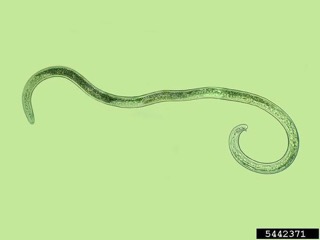Meloidogyne Incognita: Difference between revisions
Jump to navigation
Jump to search
No edit summary |
|||
| Line 29: | Line 29: | ||
Root-Knot Nematodes have multiple juvenile stages in their lifetime. In their earliest juvenile forms, male and female nematodes are vermiform, meaning they appear like skinny worms. These nematodes grow through molting and shedding their outer layer to allow them to increase in size. Adult males keep the worm shape, whereas females grow into a more spherical shape as they grow. These nematodes grow to be 1/10 the size of a pinhead and are too small to be seen by the human eye, they're also transparent. Females plant their eggs at the root surface in the [[soil]].[2] | Root-Knot Nematodes have multiple juvenile stages in their lifetime. In their earliest juvenile forms, male and female nematodes are vermiform, meaning they appear like skinny worms. These nematodes grow through molting and shedding their outer layer to allow them to increase in size. Adult males keep the worm shape, whereas females grow into a more spherical shape as they grow. These nematodes grow to be 1/10 the size of a pinhead and are too small to be seen by the human eye, they're also transparent. Females plant their eggs at the root surface in the [[soil]].[2] | ||
== Habitat == | |||
Revision as of 16:54, 17 April 2025
Taxonomy
| Domain | Kingdom | Phylum | Class | Order | Family | Genus | |
|---|---|---|---|---|---|---|---|
| Classification | Eukaryota | Animalia | Nematoda | Chromadorea | Tylenchida | Heteroderidae | Meloidogyne |
The Taxonomy of the Meloidogyne Incognita also commonly called Root-Knot Nematodes [1]

Appearance & Life Cycle
Root-Knot Nematodes have multiple juvenile stages in their lifetime. In their earliest juvenile forms, male and female nematodes are vermiform, meaning they appear like skinny worms. These nematodes grow through molting and shedding their outer layer to allow them to increase in size. Adult males keep the worm shape, whereas females grow into a more spherical shape as they grow. These nematodes grow to be 1/10 the size of a pinhead and are too small to be seen by the human eye, they're also transparent. Females plant their eggs at the root surface in the soil.[2]